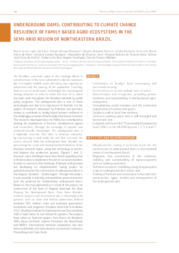Underground dams: contributing to climate change resilience of family based agro-ecosystems in the semi-arid region of northeastern Brazil.
Underground dams: contributing to climate change resilience of family based agro-ecosystems in the semi-arid region of northeastern Brazil.
Author(s): SILVA, M. S. L. da; MARQUES, F. A.; RIBEIRO, C. A.; FERREIRA, G. B.; MELO, R. F. de; BARBOSA, A. G.; LIMA, A. de O.; OLIVEIRA NETO, M. B. de; ROCHA, W. J. S. da; PARAHYBA, R. da B. V.; WEBBER, D. C.
Summary: The Brazilian semi-arid region in the Caatinga Biome is considered one of the most vulnerable to climatic variations due to irregular rainfall, water deficiency, low capacity for adaptation and the poverty of the population. Currently, there is a set of social water technologies for capturing and storing rainwater in order to make the most of it, which has been used throughout the Brazilian semiarid by public policy programs. The underground dam is one of these technologies and, due to its importance for families, it is the subject of research developed by Embrapa and partners, aiming to contribute to family-based farmers resilience to the challenging weather of the Brazilian Northeast Semiarid.
Publication year: 2021
Types of publication: Book sections
Unit: Embrapa Soils
Keywords: Barragem Subterrânea, Dams (hydrology)
Observation
Some of Embrapa's publications are published as ePub files. To read them, use or download one of the following free software options to your computer or mobile device. Android: Google Play Books; IOS: iBooks; Windows and Linux: Calibre.
Access other publications
Access the Agricultural Research Database (BDPA) to consult Embrapa's full library collection and records.
Visit Embrapa Bookstore to purchase books and other publications sold by Embrapa.

